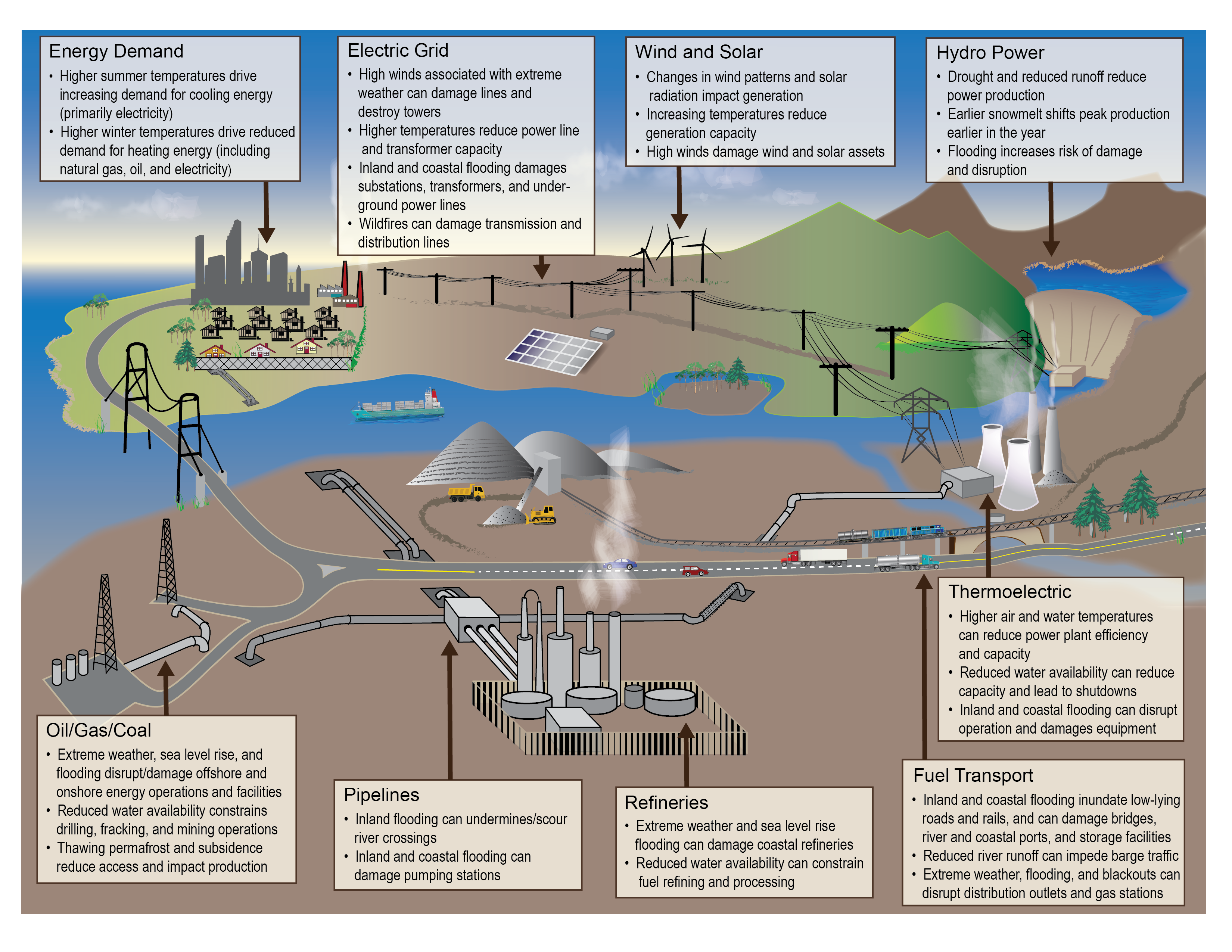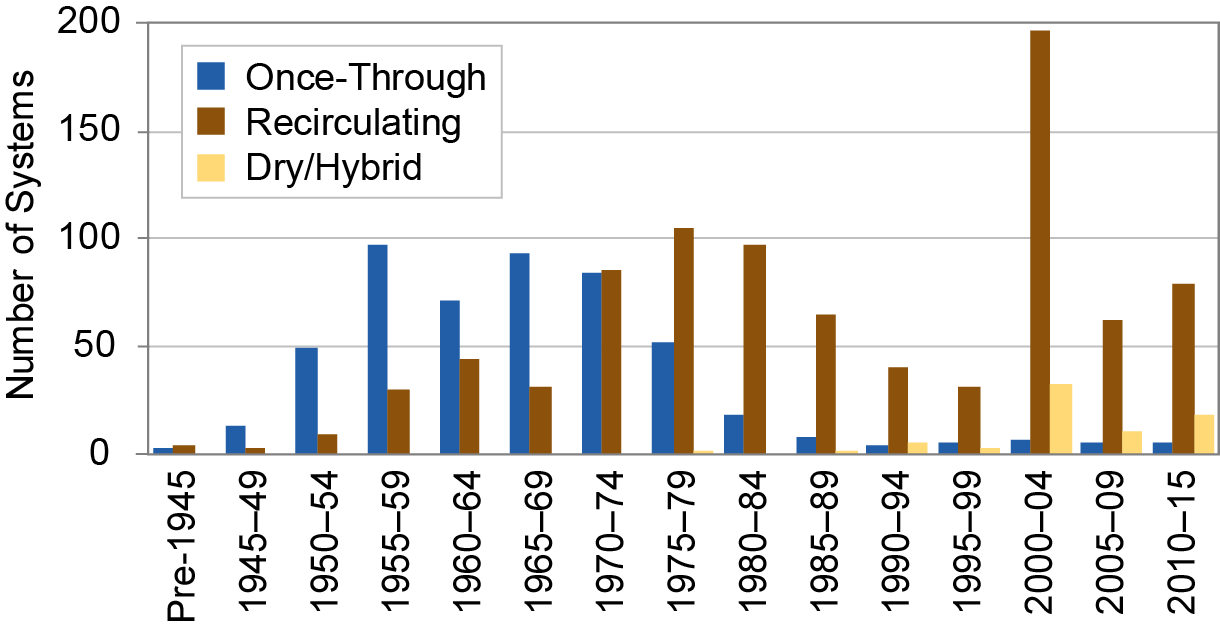EXECUTIVE SUMMARY:
ENERGY SUPPLY, DELIVERY, AND DEMAND
Summary Overview
The nation’s economic security is increasingly dependent on an affordable and reliable supply of energy (DOE 2015b, 2017). Every sector of the economy depends on energy from manufacturing to agriculture, banking, healthcare, telecommunications and transportation. Increasingly, climate change and extreme weather events are affecting the energy system threatening more frequent and longer-lasting power outages and fuel shortages. Such events can have cascading impacts on other critical sectors, potentially affecting the nation’s economic and national security. At the same time, the energy sector is undergoing substantial policy, market and technology-driven changes that may affect these vulnerabilities.
The impacts of extreme weather and climate change on energy systems will differ across the U.S. (DOE 2015a). Energy facilities and systems located near the coasts are at elevated risk of flooding from rising sea levels and more intense hurricanes. Increases in the severity and frequency of extreme precipitation may affect inland energy infrastructure in every region. Rising temperatures will drive greater use of air conditioning in the summer months, reduce the generation capacity of thermoelectric power plants, and efficiency of the transmission grid. The increase in annual electricity demand across the country for cooling is offset only marginally by the relatively small portion of the decline in electricity demand for heating. Severe drought along with reductions in mountain snowpack will affect hydropower production. Reduced water availability may threaten oil and gas drilling and refining, as well as thermoelectric power plants that rely on surface water for cooling. Dryer conditions may also increase the risk of wildfires and damage to energy assets and the power grid.
Addressing these challenges is possible, and industry and governments at the local, state, regional, federal and tribal level are taking actions to improve the resilience of the Nation’s energy system, including planning and operational measures that seek to anticipate climate impacts and prevent or respond to damages more effectively, and hardening measures to protect assets from damage during extreme events (Con Ed 2013, DOE 2015a, Entergy 2010, Exelon 2015, PG&E 2016, Seattle City Light 2015, TVA 2014). While steps are being taken, escalation of the pace, scale and scope of efforts is needed to ensure the safe and reliable provision of energy, and establish a climate ready energy system to address present and future risks.
Fig. 4.1: Potential Energy Sector Impacts from Extreme Weather and Climate Change

State of the Sector
The Nation’s economic security is increasingly dependent on an affordable and reliable supply of energy. Every sector of the economy depends on energy, from manufacturing to agriculture, banking, healthcare, telecommunications, and transportation (DOE 2017). Increasingly, climate change and extreme weather events are affecting the energy system (including all components related to the production, conversion, delivery, and use of energy ), threatening more frequent and longer-lasting power outages and fuel shortages (DOE 2015a). Such events can have cascading impacts on other critical sectors (Horton et al. 2016; Rosenzweig et al. 2017) potentially affecting the Nation’s economic and national security. At the same time, the energy sector is undergoing substantial policy, market, and technology-driven changes (DOE 2017, 2017b). Natural gas and renewable resources are moving to the forefront as energy sources, forcing changes to the design and operation of the Nation’s gas infrastructure and electrical grid. Steps are being taken to ensure the safe and reliable provision of energy (DOE 2017, 2017b, 2015b, 2015c). However, much work remains to establish a climate-ready energy system to address present and future risks.
Regional Summary
Energy systems and the impacts of climate change differ across the United States, but all regions will be affected by a changing climate. The petroleum, natural gas, and electrical infrastructure along the East and Gulf coasts are at increased risk of damage from rising sea levels and hurricanes of greater intensity (see Ch. 18: Northeast and Ch. 19: Southeast). This vulnerable infrastructure serves other parts of the country, so regional disruptions will have national implications. Hawai‘i and the U.S. Caribbean regions (see Ch. 27: Hawai‘i and Pacific Islands and Ch. 20: U.S. Caribbean) are especially vulnerable to sea level rise and extreme weather, as they rely on imports of petroleum through coastal infrastructure, ports, and storage facilities. Alaskan oil and gas operations are vulnerable to thawing permafrost which, together with sea level rise and dwindling protective sea ice (see Ch. 26: Alaska), may damage existing infrastructure and restrict seasonal access; however, a longer ice-free season may enhance offshore operations and transport. More frequent and intense extreme precipitation events may increase the risk of floods for inland energy infrastructure, especially in the Northeast and Midwest (see Ch. 18: Northeast and Ch. 21: Midwest). Temperatures are rising in all regions, which will drive greater use of air conditioning for space cooling in summer months. The increase in annual electricity demand across the country for cooling is offset only marginally by the relatively small portion of the decline in heating demand that is met with electric power. In addition, higher temperatures reduce the generating capacity of thermoelectric power plants and the efficiency of the electric grid. Energy systems in the Northwest and Southwest (see Ch. 24: Northwest and Ch. 25: Southwest) are likely to experience the most severe impacts of changing water availability, as reductions in mountain snowpack and shifts in snowmelt timing affect hydropower production. Drought may threaten fuel production, such as fracking for natural gas and shale oil and enhanced oil recovery in the Northeast, Midwest, Southwest, and Northern and Southern Great Plains as well as oil refining and thermoelectric power generation that relies on surface water for cooling. In the Midwest, Northern Great Plains (see Ch. 22: Northern Great Plains), and Southern Great Plains (see Ch. 23: Southern Great Plains), higher temperatures and reduced soil water content may make it more difficult to grow biofuel crops.




